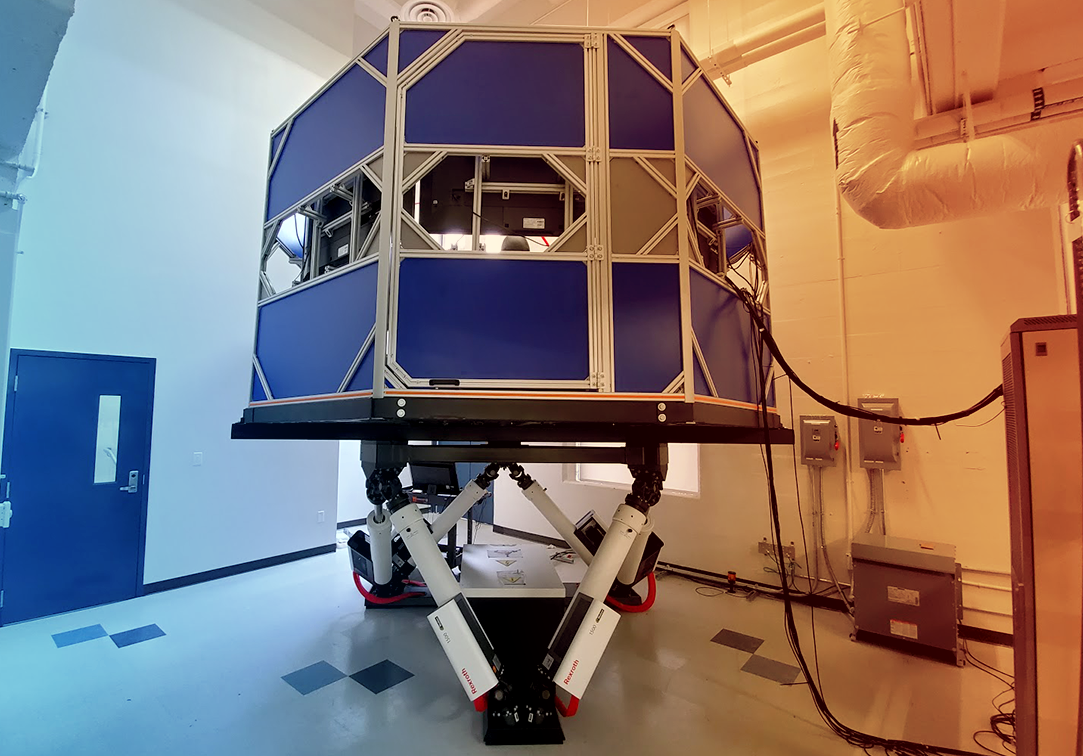 In Spring 2020, the Department of Industrial & Systems Engineering (ISE) at the University of Florida introduced a new driving simulator that will be utilized in the Human Systems Engineering Laboratory (HSEL) for driver behavior and autonomous vehicle research.
In Spring 2020, the Department of Industrial & Systems Engineering (ISE) at the University of Florida introduced a new driving simulator that will be utilized in the Human Systems Engineering Laboratory (HSEL) for driver behavior and autonomous vehicle research.
This new driving simulator represents a world-class research resource. The simulator integrates a Bosch motion platform that supports a Hyundai vehicle cab. The cab, which has driver controls and advanced driver assistance system interfaces, is surrounded by a 360-degree visualization frame with eight ultra-high-definition display screens.
The simulator also includes one of the most advanced driving vehicle simulation software applications currently available on the commercial market. The software platform and its environment lighting models are unlike any other and are critical to rendering various types of driving scenarios.
In addition to state-of-the-art equipment and software, the simulator is also integrated with a host of data collection systems that include motion tracking cameras, driver eye tracking systems, and physiological response measurement sensors. This technology allows researchers to obtain a detailed picture of a driver’s physical and cognitive states during a broad range of simulated driving scenarios.
The HSEL already has multiple simulator research projects being conducted. David Kaber, Ph.D., Professor and Department Chair is currently working on three research projects that are all funded by the North Carolina Department of Transportation and the UF Foundation through a Collaborative Research Seed Funding (CRSF) Program delivered by the ISE Department.
Dr. Kaber, Jing Feng, Ph.D., and Chris Cunningham from North Carolina State University are collaborating on a project that will assess in-vehicle messaging of non-safety-related information on driver visual behavior and vehicle control.
Dr. Kaber and Mr. Cunningham are also working on a second project that analyzes the effects of roadway markings and signing configurations on driver situation awareness and workload in negotiating novel highway interchange configurations/geometries.
The third project involves Dr. Kaber and Thomas Chase, Ph.D., from the North Carolina State University Institute for Transportation Research and Education. The team is currently evaluating driver behavior and performance in navigating corridors with variations in interchange designs and configurations.
Future research that is expected to develop out of the HSEL includes the study of autonomous vehicle user/driver takeover behavior under safety-critical conditions involving roadway pedestrians. This type of research is not possible in real-world scenarios, making the driving simulator an excellent tool for advancing knowledge of autonomous vehicle interactions.
“The Herbert Wertheim College of Engineering provided substantial support for this new simulator as major research instrumentation for faculty and students working in human-systems. Beyond our current applied research, some new faculty, like Drs. Wayne Giang and Sanaz Motamedi, have proposed to use the simulator for testing driver acceptance of advanced driver assistance systems (ADAS) with a focus on partial and fully-automated vehicle control. I expect this line of research to result in recommendations for manufacturers on new approaches to presenting vehicle automation,” said Dr. Kaber.